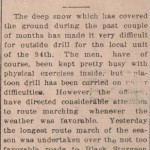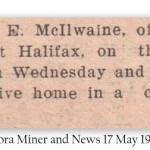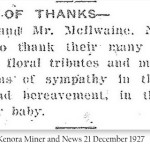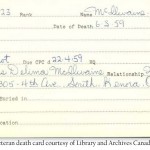

| Personal Details | |
| Date of Birth | April 5, 1888 |
| Place of Birth | Workington, Cumberland County |
| Country | England |
| Marital Status | Single |
| Next of Kin | James McIlwaine (father), Belfast, Ireland |
| Trade / Calling | Teamster |
| Religion | Roman Catholic |
| Service Details | |
| Regimental Number | 199023 |
| Service Record | Link to Service Record |
| Battalion | 43rd Battalion |
| Force | Canadian Expeditionary Force |
| Branch | Canadian Infantry |
| Enlisted / Conscripted | Enlisted |
| Place of Enlistment | Kenora, Ontario |
| Address at Enlistment | Norman, Ontario |
| Date of Enlistment | February 11, 1916 |
| Age at Enlistment | 27 |
| Theatre of Service | Europe |
| Prisoner of War | No |
| Survived War | Yes |
| Death Details | |
| Date of Death | March 6, 1959 |
| Age at Death | 70 |
| Buried At | Lake of the Woods Cemetery, Kenora, Ontario |
| Plot | RCE Row 27 Grave 14 |
McIlwaine, John Edward
Private John Edward McIlwaine served for two years in France and Belgium with the 43rd Battalion (Cameron Highlanders of Canada). He was wounded twice and became ill with influenza but he survived the war.
John was born on 5 April 1888 in Workington, Cumberland County, England. His parents, James McIlwaine and Margaret McLoughlan, were both born in Ireland. James was a blacksmith and he and his wife had at least six children: Ellen, Margaret, James, Elizabeth, John and Charles. In 1891 they were still living in Workington but by the time of the 1901 census the family had moved to Belfast and John’s father was a widow. In 1911 John was working as a shipyard labourer in Belfast and living with his sister Ellen (Mrs. John Scott). He immigrated to Canada in the spring of 1913, at age 25, arriving on 26 May on the SS Athenia with his destination listed as Keewatin, Ontario.
By early 1916 John was working as a clerk and teamster at Holden Ritchie’s grocery store in the village of Norman. He enlisted in the neighbouring town of Kenora on 11 February 1916, joining the 94th Overseas Battalion. The 94th was based in Port Arthur and recruited throughout northwestern Ontario. In May the Kenora volunteers were sent to Port Arthur to join the rest of the unit. They left for Quebec two weeks later and spent a short time at Valcartier Camp in Quebec before embarking from Halifax on 28 June on the SS Olympic. In England the recruits were absorbed into reserve battalions to be used as reinforcements for other units.
John trained for a month with the 17th Reserve Battalion. On 24 August he was transferred to a front line unit, the 43rd Battalion (Cameron Highlanders of Canada), and sent to France. However, before he joined them in the field he was reclassified as permanent base, due to flat feet, and he was posted instead to the Canadian Corps Composite Company. He served with the Composite Company until the end of February 1917 when he was sent to join the 43rd Battalion in the field. Around that time the Canadians began training for their next major assault, the Battle of Vimy Ridge (9-14 April 1917). It was the first time all four Canadian Divisions were used in one operation and the carefully planned attack was a remarkable success.
On 1 May the 43rd Battalion relieved another unit in the front lines north of Vimy and they suffered 25 casualties during their five days in the trenches. John was reported wounded on the last day, 5 May. He was admitted to No. 23 Casualty Clearing Station with a shell or gunshot wound to his right leg. Five weeks later he had recovered from his injury and he rejoined the 43rd Battalion in mid-June. In August they took part in the Battle of Hill 70, near Lens in France, and that fall they were moved north for the assault on Passchendaele Ridge. The Passchendaele operation was carried out in several phases starting on 26 October. The 43rd Battalion took part in the first phase, advancing up the Bellevue Spur very early on the morning of 26 October. They reached their objectives and dug in until they were relieved on the night of 27-28 October. Following the operation the battalion provided stretcher bearers to carry out the wounded then remained behind the lines for two weeks.
On 11 November, the day after Passchendaele was captured, John’s unit went into the trenches for a three-day rotation. He was one of the casualties on the first day, suffering a shrapnel wound to his left leg. He was admitted to a casualty clearing station then evacuated to No. 7 Canadian General Hospital in Г‰taples on 14 November. The wound wasn’t serious and John rejoined his unit about five days later. In December he had a two-week leave of absence and in February 1918 he was awarded a good conduct badge for two years of service. That summer the Canadian Corps underwent intensive training in open warfare and they were heavily involved in the final months of the war (the Hundred Days Offensive). There was little rest for the 43rd Battalion during that time. The Prince of Wales paid them a visit on 9 November and that same night the troops moved into Belgium. The Armistice was signed two days later and they stayed in Belgium for several more months. In December John had a two-week leave of absence, for private family matters, and he rejoined his unit in early January 1919. They moved to Le Havre a month later and embarked for England on 10 February on HMTS Lorina. After proceeding to Bramshott Camp most of the men were given eight days leave. John, unfortunately, became ill with influenza and on 12 February he was admitted to the Bramshott military hospital where he spent the next three weeks. Following his recovery he was assigned to the Manitoba Regiment Depot for two months before he returned to Canada. He arrived in Halifax on the Royal George on 14 May and he was officially discharged on 17 May in Port Arthur.
After his war service John returned to Norman to live. When the 1921 census was taken he was lodging with Holden Ritchie and his family and employed as a clerk. In 1922 he was hired as a baggage man for the Canadian Pacific Railway and he worked for them for 26 years. Sometime in the early 1920s he married a Kenora girl, Rose Delima LaRivière. Rose was born in Letellier, Manitoba, the daughter of Gédéon LaRivière and Marie Louise Messier. Her family had moved to Rat Portage (later called Kenora) when she was very young. Her brother Alexandre LaRiviere was a war veteran who spent over two years in France with the 25th Battalion.
John and Rose made their home in Norman. Sadly they lost their only child, a daughter who died in December 1927 at age three months. John became a member of the Kenora branch of the Canadian Legion. In the spring of 1936 he went on a trip to Belfast, Ireland to visit his family. He passed away at Deer Lodge Veterans Hospital in Winnipeg on 6 March 1959, at age 70. His wife died in 1985 and they are buried along with their daughter in the Roman Catholic Block of Lake of the Woods Cemetery,
By Becky Johnson












